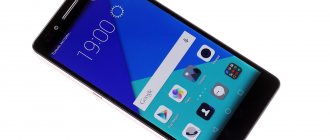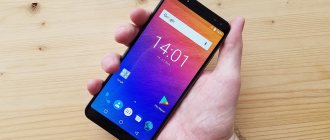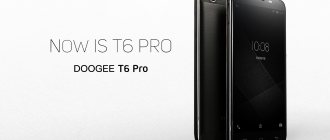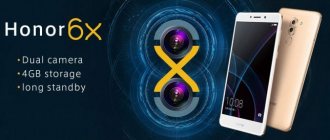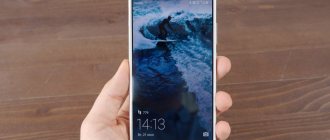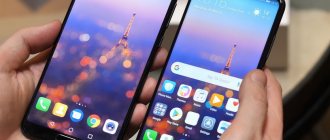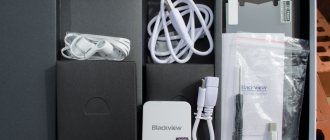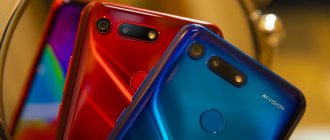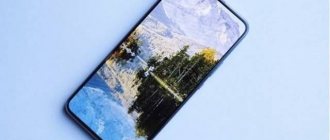Model description
In 2014, it launched a budget smartphone, which was considered one of the best devices of that time. The new product is the stylish Xiaomi Redmi 2 phone, equipped with the necessary functionality for comfortable use by consumers. It was equipped with a new processor and a more powerful battery, thereby increasing the capabilities of the mobile device. Despite the fact that in recent years the company has released many interesting smartphones, this model is still popular and in demand among buyers. In order to better understand its capabilities, you need to look at the characteristics in more detail.
Iron
At the heart of the device lies a fairly fresh 64-bit Snapdragon 410 processor with a clock frequency of 1.2 GHz, coupled with 1 GB of RAM and 8 GB of ROM.
The performance is quite enough to run the latest games without lags at medium settings. The exception was Asphalt 8, which automatically set it to high.
If you want more power, you can overpay about $15-$20 and get the 2 GB RAM version.
In popular tests, Xiaomi Redmi 2 scores average, however, I repeat, no lags were noticed when using it (most likely this is optimization).
Equipment
To package the phone, manufacturers use a standard box made of thick cardboard. It is quite reliable for transportation and does not deform under heavy loads.
Inside, in addition to the device, there is the necessary documentation, a one-amp charger and a USB cable. Adapter and headphones are not included.
Availability of communications
The gadget operates in 4G/3G networks. Most other network features are standard. Wi-Fi only supports one band - 802.11 b/g/n (2.4 GHz). Bluetooth is introduced in version 4, OTG connection is supported, but NFC is missing.
The device supports communications such as Wi-Fi Display and Wi-Fi Direct. The wireless point is organized using Bluetooth or Wi-Fi access channels.
The navigation module works without failures and is capable of recognizing satellites of three systems: Glonass, GPS and BDS. A magnetic field sensor is also provided. It is used to operate an electronic compass in navigation programs.
Xiaomi Redmi 2 is equipped with 2 SIM card slots, the connectors have equivalent capabilities. You can select the main map and subsequently switch between them from the menu.
Design
The appearance of the Xiaomi Redmi 2 smartphone is the most ordinary; it does not stand out in anything striking. The small case is made of plastic, on the front panel glued to glass. There are no decorative elements, even in the form of a rim. The phone is compact, its dimensions are: 134 x 67.2 x 9.2 mm, and its weight is 132 grams. The case type is monoblock, the edges of which are flat, the corners are slightly rounded. The manufacturer produces the phone with a body in white, black, pink, yellow and green.
Above the display there is space for the following elements:
- front camera;
- proximity and lighting sensor;
- conversational dynamics.
Below the display there are mobile device control buttons and an alert LED.
Mechanical keys that allow you to turn on the device and adjust the volume are located on the right side. The main camera is installed in the center of the back cover, to the left of it is an LED flash consisting of one section, and to the right is a speaker in the form of two parallel small slits. They are slightly raised above the surface, so the sound is heard well if the Xiaomi Redmi 2 phone lies with its back side on the surface.
The cover is removable, under it there is a battery, and 2 slots intended for micro SIM and SD cards. They are replaced only after the battery has been removed.
The USB connector and the main microphone are located at the bottom, and the headphone input is located at the top (at the end).
Equipment and appearance
The smartphone comes in the standard red box that Xiaomi uses for all Redmi series devices. There is nothing interesting to tell about the package: a charger, a connecting cable and a simple transparent silicone case. Budgeting is felt in everything.
The design of Redmi S2 cannot be called spectacular. A laconic shovel phone with an 18:9 aspect ratio and a silver plastic lid. It looks like metal, and even has special slots in the top and bottom, which are usually made for antennas. But no, it's plastic.
Some may attribute this circumstance to the obvious disadvantages of the phone, but take your time. Thanks to the use of plastic, the S2 turned out to be lighter and thinner. It doesn't get so hot in the summer and doesn't freeze your hands in the winter. And anyway, most users will immediately put a silicone case on their smartphone, so does it make a difference what the back is made of?
The dual camera unit is located on the back side in the upper left corner. The fingerprint scanner is located in the center, it is easy to locate with your index finger and responds instantly.
The right side traditionally houses the power button and volume rocker. On the opposite side there is a slot for two SIM cards and a memory card. It has three cells, which allows you to use cards from two operators and microSD.
The top edge contains a headphone jack, a microphone and an infrared port for controlling household appliances. On the bottom there is a microUSB socket, a conversational microphone and an external speaker. The latter are hidden behind holes in the case, symmetrically located to the left and right of the connector.
The front side of Redmi S2 is occupied by a large screen with a diagonal of 5.99 inches. It is completely flat, which will be appreciated by those who like to glue protective films and glass. The display is surrounded by frames that are quite thick by today's standards, the thickness of which reaches 3.5 mm on the sides, and 12 mm on the top and bottom. The corners of the screen are rounded.
In general, the appearance of the Redmi S2 is fully consistent with fashionable mobile trends, although it is devoid of any originality. However, you can’t expect anything else from a budget device.
Display
The Xiaomi Redmi 2 smartphone with an IPS matrix has a diagonal of 4.7 inches and its resolution is 1280 x 720 pixels. Thanks to the existing light sensor, brightness adjustment occurs automatically. When certain parameters are set, the picture will be clear in sunny, clear weather. There is no color distortion observed on the screen, since the viewing angles are quite good. The adjustment can also be adjusted manually.
The display is able to recognize 10 touches.
Test results showed that the screen of the Redmi 2 phone is very good: a large reserve of brightness, correct color rendition, rich color gamut, anti-reflective coating. It is good for the user during day and night time. The only drawback is the unstable black image.
Connecting a SIM card (Micro)
Insert the Micro SIM/UIM card into the left slot and carefully push it all the way in. Be careful : in order for the Redmi 2 model to gain access to the Micro SIM / UIM card slot, you must first remove the battery. It is recommended to remove the card only after turning off the phone. This will avoid system failure.
- The memory card must be inserted into a special slot in a special way - with the contact surface facing down.
- The device must be pushed in as far as possible.
Technical characteristics of Xiaomi Redmi 2
Considering the budget price of the Xiaomi Redmi 2 smartphone, its characteristics are not bad. The phone runs on Android 4.4.4 OS. with the proprietary MIUI 6 shell. The device interface is laconic and neat. The settings are clear and easy to use.
The mobile device is available in two versions - with 1 and 2 GB RAM and built-in memory - 8 and 16 GB. It can be expanded up to a maximum of 32 GB. The phone supports memory cards: micro SDXC, SDHC, SD. The mobile device is designed to use two SIM cards. It has functions: speakerphone and conference calling, gyroscope, vibration mode, speed dialing, video calls and others that make the user's work easier. The smartphone has built-in Wi-Fi, GPS, Bluetooth, radio, turn orientation sensors, and a video player.
Detailed technical specifications
Make and model
Make and model of the device, and alternative names (if any).
| Brand Device manufacturer company. | Xiaomi |
| Model Device name. | Redmi 2 |
| Alternative names Other model names, if available. Sometimes the model is called differently, depending on the country or because of popular nicknames. | Hongmi 2 |
Design
Appearance of the device including dimensions, weight, volume, colors and materials.
| Width The horizontal side of the device when used in standard orientation. | 67.2 mm (millimeters) |
| Height The vertical side of the device when used in standard orientation. | 134 mm (millimeters) |
| Thickness The cross-sectional size of the device. | 9.4 mm (millimeters) |
| Weight How much does the device weigh excluding the case, SIM and memory cards and other additional elements. | 133 g (grams) |
| Volume Approximate value calculated using the formula: length times width times height. | 84.65 cm³ (cubic centimeters) |
| Colors What colors is the device available in? | White Yellow Green Pink Gray |
| Housing materials What materials is the body made of? | Plastic |
System on a Chip (SoC)
A system on a chip, a single-chip system (System on a Chip, SoC) is when several systems performing different device functions are connected on one chip.
| System on a Chip (SoC) A single-chip system that contains components such as a processor, graphics accelerator, memory units, communication interfaces, etc., as well as software for the operation of the system. | Qualcomm Snapdragon 410 MSM8916 |
Central processing unit (CPU)
| Central processing unit (CPU) The main component of the device is responsible for calculations and data processing. | ARM Cortex-A53 |
| Technical process What technological process is used to make the chip? The smaller the process technology, the better - the chips consume less power and generate less heat. | 28 nm (nanometers) |
| Processor size Processor capacity is a parameter that indicates how many bits of data a processor register processes in 1 clock cycle. This is usually 32 or 64 bits. | 64 bit |
| Instruction Set Architecture Instruction set architecture (ISA) is a programmable part of the microprocessor core used by software to control the operation of the processor. | ARMv8 |
| Number of processor cores The processor can be either single-core or multi-core. The performance of the processor depends on the number of cores (threads). The more cores working simultaneously, the higher the power consumption, so in mobile devices all cores are used only under high load. | 4 |
| CPU clock speed Clock speed is the number of operations per second that a processor or its core can achieve. The higher the frequency, the higher the overall performance of the device, but performance also depends on the processor architecture and the number of cores. | 1200 MHz (megahertz) |
Graphics Processing Unit (GPU)
| Graphics Processing Unit (GPU) The graphics processing unit (GPU) is used to process and display graphics - 3D effects, games, interfaces and other visual elements. Due to the pipeline architecture, the GPU is many times more efficient in graphics processing than the processor. | Qualcomm Adreno 306 |
| GPU clock speed Clock speed is the number of operations per second that the GPU or its core is capable of achieving. The higher the frequency, the higher the speed of the processor, and therefore the number of tasks it can solve. | 400 MHz (megahertz) |
Random access memory (RAM)
| Amount of random access memory (RAM) RAM (Random Access Memory, RAM, RAM) is temporary memory (works only while the device is running), which stores data and code for the operational operation of programs and applications. The more RAM, the more programs you can run simultaneously without loss of performance (there will be fewer “brakes”). | 1 GB (gigabytes) 2 GB (gigabytes) |
| Type of random access memory (RAM) Information about the type of RAM used by the device. | LPDDR3 |
| Number of RAM channels 1 is a single-channel RAM operating mode, basic, when 1 memory module is used. 2 is already a two-channel mode - a mode of parallel operation of 2 modules or pairs of modules, memory channels - this mode is 2 times faster than a single-channel one. 3 – three-channel mode is 3 times faster than single-channel mode. | Single channel |
| RAM frequency The frequency of RAM determines the speed of RAM, or rather the speed of data transfer and reception. In theory, the higher the frequency, the more powerful the RAM. | 533 MHz (megahertz) |
Built-in memory
Most mobile devices have built-in Flash memory, which is used as a storage for system data, the operating system, as well as user data - photos, videos, recordings and much more.
| Built-in memory capacity The higher the amount of built-in memory, the more games, programs, music, videos and your other files will fit in the device, especially the amount of memory is important when the device does not support memory cards. | 8 GB (gigabytes) 16 GB (gigabytes) |
Operating system
A mobile operating system (OS) is pre-installed software with a well-thought-out interface for user control of device functions.
| Operating system (OS) The operating system installed by default by the device manufacturer, as well as its version. | MIUI V6 (Android 4.4.4 KitKat) MIUI V7.2 (Android 4.4.x KitKat) MIUI V9 |
Battery
To operate autonomously, a mobile device requires a battery that powers all its components.
| Battery capacity The main characteristic of a battery is its maximum capacity, that is, the charge it can store. Capacity is measured in mAh (mAh, milliamp-hour). The higher the capacity, the longer the mobile device can work. | 2200 mAh (milliamp-hours) |
| Battery type Many types of batteries have been used in portable devices, but NiCd (nickel-cadmium), NiMH (nickel-metal hydride), and even more so SLA (lead-acid) batteries are already considered obsolete. Instead, modern mobile devices use Li-Ion (lithium-ion) and Li-Pol, Li-Poly (lithium-polymer) batteries. | Li-Ion (Lithium-ion) |
| Fast charging Fast charging is when the device charges very quickly. For example, up to 50-70% of a full battery charge in ten minutes. | Yes |
| Fast charging technology What fast charging technology does the mobile device support? Fast charging is when the device charges very quickly, for example up to 50-70% of the full battery charge in ten minutes. | Qualcomm Quick Charge 1.0 |
Screen
The screen (display) is the main element for displaying graphic information.
| Technology The technology used to make the screen. There are many types of display manufacturing with their pros and cons. | IPS |
| Diagonal The screen diagonal of a device is measured in inches (inch, in or simply ″), and 1″ is equal to 2.54 cm. | 4.7 in (inches) 119.38 mm (millimeters) 11.94 cm (centimeters) |
| Width Approximate screen width | 58.53 mm (millimeters) 5.85 cm (centimeters) |
| Height Approximate screen height | 104.05 mm (millimeters) 10.4 cm (centimeters) |
| Aspect Ratio Aspect ratio is the ratio of the shorter side of the screen, which is considered to be 1, to the longer side, which is denoted by a decimal fraction indicating the ratio to the short side. | 1.778:1 16:9 |
| Screen resolution Screen resolution is the number of horizontal pixels (dots) multiplied by the number of vertical pixels. The higher the resolution, the more detailed the image will be. | 720 x 1280 pixels |
| Pixel Density The number of pixels per inch or PPI (pixels per inch) indicates the density of pixels per 1 inch (2.54 cm) of the screen. The higher the PPI, the sharper the image, and the less visible or even invisible “squares and dots” (pixels). | 312 ppi (pixels per inch) 122 ppcm (pixels per centimeter) |
| Color depth Color depth means how many bits are used in 1 pixel to display color (bits per pixel). | 24 bit 16777216 colors |
| Screen area Approximate usable area occupied by the screen on the front of the device. The higher the percentage, the narrower the frames around the display or the smaller the “chin with bangs.” | 67.85% (percent) |
| Touch screen A touch screen is a device that usually covers the display and is a touch input tool. In fact, in mobile devices, the touchscreen is a replacement for the keyboard and mouse. | Yes |
| Touch screen type There are many types of touch screens, with their pros and cons. Mobile devices often use capacitive touchscreens, but technology does not stand still and new types of sensors are appearing. | Capacitive |
| Multi-touch Touch screen support for two or more touches. For example, zooming photos with two fingers. | Yes |
| Impact-resistant protective glass of the display The screen and touchscreen of a mobile device are usually covered with protective tempered glass (sometimes plastic or film is used instead of glass) to protect the display from impacts and scratches. Many companies are engaged in the production of such protection, but the most famous are Corning - Gorilla Glass and Asahi - Dragontrail. | Yes Dragontrail glass |
Main camera
The main camera, usually built into the rear of the device, is designed for creating photo and video content.
| Photomatrix model An image sensor (matrix) is a light-sensitive sensor that converts an optical image into electrical signals that the device can subsequently process. | OmniVision OV8825 |
| Maximum image resolution This is the maximum number of pixels (dots) horizontally and vertically. The higher the resolution, the more detailed the image will be. Resolution can also be indicated in megapixels - this is the total number of pixels that can be in the image, calculated by the formula: vertical pixels multiplied by the number of horizontal pixels and divide the resulting amount by 1 million. | 3264 x 2448 pixels 7.99 MP (megapixels) |
| Matrix type There are two main types of photomatrix, CCD (Charge-Coupled Device) and CMOS (Complimentary Metal-Oxide Semiconductor). Mobile devices mainly use a CMOS matrix - it requires less space, has low power consumption and heating. Recently, new types of sensors have begun to appear, for example PureCel from OmniVision. | CMOS BSI (backside illumination) |
| Matrix size The larger the physical dimensions of the sensor, the larger pixels can be installed there or the greater their number, increasing the luminous flux and exposure. That is, the larger the size, the better. | 4.61 x 3.44 mm (millimeters) 0.23 in (inches) |
| Matrix pixel size Pixel size is one of the matrix parameters that determines what size pixels are used in the matrix. The larger the size, the better - less noise and a larger light-sensitive area. | 1.414 µm (micrometers) 0.001414 mm (millimeters) |
| Crop factor The crop factor is the ratio between the dimensions of a small format 35 mm matrix (36 x 24mm) and the size of the device matrix. That is, how much is our matrix smaller than the 35 mm matrix. Almost all cameras have smaller matrices, and the indicator itself is more of a reference value. | 7.51 |
| Focal length Focal length is the distance from the center of the lens to the image sensor. | 3.73 mm (millimeters) 28.01 mm (millimeters) *(35 mm / full frame) |
| Diaphragm Aperture (f-number, f) is used to control the light flux passing through the lens. The aperture is indicated by a fraction, and the smaller the fractional number, the higher the aperture passing through the lens. The more light that passes through the lens, the better overall, less noise in your photos and better night photography. | f/2.2 |
| Flash type Most mobile devices are equipped with light-emitting diode (LED) flashes, but there are also xenon flashes. As a flash, xenon is better - it is more powerful, but LED is more versatile (can work as a flashlight) and consumes less electricity. | LED |
| Maximum video resolution This is the maximum number of pixels (dots) horizontally and vertically. The higher the resolution, the more detailed the image will be. | 1920 x 1080 pixels 2.07 MP (megapixels) |
| FPS video recording at maximum resolution FPS (Frames per Second, frame rate) is the number of frames that changes in 1 second. The higher the number of frames per second, the smoother the image will be. In this case, we mean the number of frames that the camera can achieve at its maximum resolution; the lower the resolution, the higher the FPS can be. | 30 fps (frames per second) |
| Presence of flash Incorporating a flash into a mobile device allows you to take pictures in low light conditions. Creates the necessary lighting and compensates for the lack of natural light. | Yes |
| Digital zoom With digital zoom (zoom, enlargement), the subject is brought closer due to software image algorithms. The higher the magnification with digital zoom, the worse the image quality (noise, blur) will be compared to a non-zoomed one. | Yes |
| Number of lenses in the lens This is the number of optical elements (lenses) that are contained in the optical circuit of a camera lens. | 5 |
| Focus on face Function of auto-detection of living objects and autofocus on their face or head. | Yes |
| HDR shooting mode HDR photography takes a quick series of shots with highlights, midtones, and shadows, then combines them into a single frame with high dynamic range. | Yes |
| White balance White balance is a setting that helps ensure the correct color reproduction in an image by determining the color temperature of the light source in the frame. The balance can be set either automatically or manually. | Yes |
| ISO Setting ISO is the level of light sensitivity. The lower the ISO, the less sensitive the camera's light sensor and the smoother the image with less noise. The higher the ISO, the higher the light sensitivity, but more noise, graininess, or decreased sharpness. | Yes |
| Additional Information Additional information about the functions and characteristics of cameras. | Autofocus Continuous Shooting Geo-tagging Touch Focus Exposure Compensation Scene Selection Mode |
Front-camera
The front camera of a mobile device (selfie camera, rear camera) is a camera on the front part, which is usually used for video communication, recognition of gestures or faces, and selfie photographs.
| Photo resolution The maximum image resolution that the camera can produce. As resolution increases, image detail increases. Resolution can also be indicated in megapixels (the total number of pixels that an image can consist of) - these are vertical pixels multiplied by horizontal pixels and divided by 1 million. | 1600 x 1200 pixels 1.92 MP (megapixels) |
| Video resolution This is the maximum resolution the camera can record video at. The higher the resolution, the better. | 1280 x 720 pixels 0.92 MP (megapixels) |
Memory card
A memory card (flash card) is an external data storage device that is used in many devices to increase memory capacity.
| Memory card type and formats Mobile devices usually use 3 types of memory cards - SD, miniSD and the most common microSD. Each type has its own formats that the device supports. | microSD microSDHC microSDXC |
SIM card
Subscriber Identification Module (SIM) used in mobile devices to identify subscribers in cellular networks.
| Type, size of SIM card A regular (mini SIM) card has dimensions of 25x15 mm. Micro SIM - 15x12 mm. Nano SIM - 12.3x8.8 mm. The sizes of SIM cards are different and not interchangeable. There is also an eSIM (virtual, electronic SIM card), it is built into the device and does not take up space. | Micro-SIM (3FF - third form factor, since 2003, 15.00 x 12.00 x 0.76 mm) |
| Number of SIM cards How many SIM cards does the device support? | 2 |
Mobile networks
This is a system in which communication and data transfer is carried out between subscribers, the location of one or more of which changes. This section lists the supported mobile communication standards and frequencies.
| GSM GSM (Global System for Mobile Communications) is a standard for digital mobile cellular communications of the second generation 2G with time and frequency division of channels. GSM came to replace analog cellular communications 1G (first generation). | GSM 900 MHz GSM 1800 MHz GSM 1900 MHz |
| TD-SCDMA TD-SCDMA (Time Division Synchronous Code Division Multiple Access) is a third generation (3G) mobile communications standard used in China. | TD-SCDMA 1900 MHz TD-SCDMA 2000 MHz |
| UMTS UMTS (Universal Mobile Telecommunications System), also called 3GSM, is a third generation (3G) mobile communications standard based on the WCDMA air interface. | UMTS 850 MHz UMTS 1900 MHz UMTS 2100 MHz UMTS 900 MHz (Redmi 2 Prime) |
| LTE LTE (Long-Term Evolution, often referred to as 4G LTE) is a standard for wireless high-speed data transmission, which, although it belongs to fourth generation networks (4G), is essentially a transitional stage from 3G to 4G, greatly accelerating data transfer speeds. The standard has an improved version, LTE Advanced (LTE-A), which can already be considered a full-fledged 4th generation network. | LTE 2100 MHz LTE 2600 MHz LTE-TDD 1900 MHz (B39) LTE-TDD 2500 MHz (B41) LTE-TDD 2600 MHz (B38) LTE 1800 MHz (Redmi 2 Prime) LTE-TDD 2300 MHz (B40) (Redmi 2 Prime) ) |
| CDMA2000 CDMA2000 (Code Division Multiple Access) is a third generation (3G) mobile communications standard that is based on CDMA to improve it. Compared to CDMA One, it is distinguished by network reliability, data transfer speed and high voice quality. | 1xEV-DO Rev. A |
Mobile network data standards
What data transfer standards in cellular networks are supported by the device, as well as their speed.
| Data transmission technologies Technologies for receiving and transmitting data, as well as their maximum speed. | UMTS (384 kbit/s) EDGE GPRS HSPA+ LTE Cat 4 (51.0 Mbit/s, 150.8 Mbit/s) EV-DO Rev. A (1.8 Mbit/s, 3.1 Mbit/s) TD-SCDMA TD-HSDPA |
WiFi
Wi-Fi (Wireless Fidelity) is a technology for wireless data transmission over a local network among devices based on IEEE 802.11 standards.
| Wi-Fi Direct support The Wi-Fi Direct protocol allows multiple devices to connect directly, bypassing the use of routers or access points. | Yes |
| Wi-Fi Hot-Spot A hotspot is a Wi-Fi access point. In a mobile device, Hot-Spot turns the smartphone into a Wi-Fi access point, essentially turning it into a router capable of distributing the Internet. | Yes |
| WiFi Supported WIFI wireless network standards. | 802.11b (IEEE 802.11b-1999) 802.11g (IEEE 802.11g-2003) 802.11n (IEEE 802.11n-2009) Wi-Fi Display |
Bluetooth
Bluetooth (BT, bluetooth (z), “blue tooth”) is a short-range wireless network (up to 10, sometimes 100 meters) operating on radio waves to transmit voice and data between devices.
| Bluetooth version Bluetooth technology is actively developing and, since 1998, has been constantly updating versions of the standard. Each subsequent version introduces one or several improvements in data exchange speed, range, facilitates pairing, reduces power consumption, or introduces some new protocols and operating profiles. The higher the Bluetooth version, the better. The technology is also backward compatible, for example, if your mobile device has version 5.0, then it will work with accessories version 4.2 and lower, but the improvements introduced in version 5.0 will not work; they will work only if both the device and accessories are version 5. | 4.0 |
| A2DP profile The A2DP Bluetooth profile is designed to transmit a high-quality two-channel stereo signal via Bluetooth to wireless headphones, speakers and other acoustics. | Yes |
Sensors
Modern devices have many sensors that help in measurements, trigger functions, and make using the device more pleasant.
| Light sensor The light sensor reacts to the light level and is able to adjust the screen brightness automatically based on this. This is necessary to reduce power consumption and ease of use of the device. | Yes |
| Proximity sensor The proximity sensor reacts to the proximity of the mobile device to some object. For example, the sensor is used when talking on the phone to turn off the screen, which saves energy and prevents you from pressing buttons with your ear or cheek. | Yes |
| Gyroscope Gyroscope (gyroscope, gyro sensor) is a sensor for orientation in space that tracks the angle of inclination of even a stationary device along three coordinate axes. The sensor is mainly used in conjunction with an accelerometer in games and applications. | Yes |
| Accelerometer An accelerometer is a sensor that measures apparent acceleration, that is, it determines the position and distance at which a mobile device moves in space. Based on the data from this sensor, the screen orientation change, pedometer, control using tilts and gestures in games and applications, etc. work. | Yes |
| Digital compass This is software that displays data from a magnetic sensor or GPS in the form of a compass on the screen of a mobile device. If there are no sensors or GPS, then the digital compass will not work. | Yes |
| Additional sensors |
Audio
Audio - characteristics and capabilities of a mobile device in terms of sound.
| Music speaker There are two types of speakers in mobile devices - auditory and musical. The auditory speaker (speaker) is used for conversation, the music speaker (buzzer) is used to play music and sounds. | Loudspeaker Earphone |
Radio
The radio in a mobile device can be built-in by the manufacturer (catch local radio channels, no internet required, often works only with headphones (as an antenna), but not always) or installed as an online application (requires internet, but more channels and often better quality) .
| Built-in radio Is a radio tuner integrated into the mobile device? | Yes |
Navigation and location
The location is determined by satellite navigation systems that track the device's autonomous geospatial location at multiple points. The most common satellite navigation systems are GPS, GLONASS, and the Chinese BeiDou.
| GPS GPS (Global Positioning System) is a global satellite navigation system that can determine the position of a mobile device, build routes and find the desired object on the map with an accuracy of several meters. | Yes |
| A-GPS A-GPS (Assisted GPS) is an assistive technology that will help you quickly find the location of your cellular device without waiting for satellite data, which is especially important in indoors and cities. Location is determined in various ways, for example, Wi-Fi access points, mobile towers, bluetooth and others. | Yes |
| GLONASS GLONASS is a Russian Global Navigation Satellite System, which is similar to GPS and works in tandem with it, increasing the accuracy and speed of navigation. | Yes |
| Additional navigation systems | BeiDou |
USB connector
USB (Universal Serial Bus) is a serial interface for connecting peripherals to computers, smartphones, laptops and much more. The interface allows you to exchange data and power a peripheral device with energy, as well as connect several peripheral devices to one USB connector at once.
| Connector type What type of USB connector is used in the device. | Micro USB |
| USB standard The higher the standard, the faster the throughput, or more precisely the data exchange rate. With version 3.0 of the standard, the current was increased to 0.9A, eliminating the need for additional power for some devices. | 2.0 |
| USB Mass Storage Connecting a mobile device via USB as a data storage device. That is, when you enable this mode, your device can be used as a flash drive. | Yes |
| USB OTG support OTG is the ability to connect peripherals, such as keyboards and mice, flash drives, card readers, and much more, to the USB port of your device via an adapter or directly. You can connect devices that do not require specialized drivers or additional power. | Yes |
| Additional characteristics Additional features of the USB connector, for example, OTG, whether the connection is supported, peripheral devices and additional memory. | Charging via USB |
Headphone jack
A TRS headphone jack (or jack) is a common standard of connectors used for transmitting audio signals. By diameter there are jack (6.5 mm), mini-jack (3.5 mm) and micro-jack (2.5 mm). In mobile devices, the 3.5mm jack was considered the most popular and widespread, but recently they began to be removed, leaving only USB connectors, through which headphones are connected with a corresponding plug or using adapters.
| 3.5mm headphone jack Does the device have a 3.5 mm audio jack? | Yes |
Connection and synchronization
Options for synchronizing your mobile device and connecting it to other devices.
| Connection, synchronization Types of synchronization and connection technologies supported by the device. | Computer sync OTA sync Tethering |
Browser
A browser is a browser program for viewing sites and their content on the Internet. Through the browser, you can open websites, search for information, download necessary files, watch streaming videos, play browser games, etc.
| Technologies Markup and programming languages supported by the built-in (standard) browser. For mobile devices, you can install additional browser applications if the standard one does not suit you. | HTML HTML5 CSS 3 |
Audio file formats/codecs
Mobile devices support many audio file formats, as well as codecs for playing them.
| Default formats The formats that the mobile device supports out of the box are indicated. But if the device does not support the format you need, then you can try adding support for it. Sometimes support depends on the technical characteristics of the device (“hardware”) and nothing can be added here, but often the ability to process a particular audio format depends on the software part. You can install another audio player or codec set separately. | AAC (Advanced Audio Coding) AMR / AMR-NB / GSM-AMR (Adaptive Multi-Rate, .amr, .3ga) eAAC+ / aacPlus v2 / HE-AAC v2 MIDI MP3 (MPEG-2 Audio Layer II, .mp3) WMA (Windows Media Audio, .wma) WAV (Waveform Audio File Format, .wav, .wave) |
Video file formats/codecs
Video file formats that the device supports and is capable of decoding and playing.
| Default formats Video file formats that the device is capable of playing with standard firmware and a standard (built-in) set of programs. Not all formats are supported by default, but you can install a third-party video player and/or set of codecs. | 3GPP (3rd Generation Partnership Project, .3gp) AVI (Audio Video Interleaved, .avi) H.263 H.264 / MPEG-4 Part 10 / AVC video MP4 (MPEG-4 Part 14, .mp4, .m4a, .m4p , .m4b, .m4r, .m4v) WMV (Windows Media Video, .wmv) |
Camera
The model of this device is equipped with two digital cameras of 2 and 8 megapixels. Despite such a small resolution of the front camera, the portrait turns out to be of decent quality. The pictures are quite bright and well detailed. The convenience of taking your own portrait is that you can use the hardware volume button for this purpose.
The main 8-pixel camera is equipped with an LED flash and autofocus, which is not very fast, but with great accuracy. The user can set the focus independently. The device has functions that allow you to change the white color, set exposure, portrait and sports photography, landscape, and light sensitivity. Using the built-in camera, you can take videos with good resolution. The camera is good for a mobile device of this level.
additional services
The multifunctional device allows you to:
- search for the necessary information using the T9 menu item (contacts, user groups, calls);
- get access to the Internet at the same time;
- use the cloud service, which makes it possible to secure data;
- recognize numbers not listed in the telephone directory;
- protect yourself from intrusive calls and SMS from certain subscribers.
Using your mobile device every day, you will discover many other useful features and little things that make your life easier.
Video playback testing
An important indicator when testing a smartphone is playback of the most common video formats and support for containers, codecs and specialized features such as subtitles.
According to mobile device experts, smartphones should have hardware decoding support that is at the chip level. This is explained by the fact that it is impossible to process most formats using processor cores. In addition, the gadget is not capable of playing all existing video formats, so you should not expect the maximum result.
During testing, Xiaomi Redmi 2 showed the ability to play all proposed videos through the standard player. There was no sound when using a third-party MX player in AC3 format.
